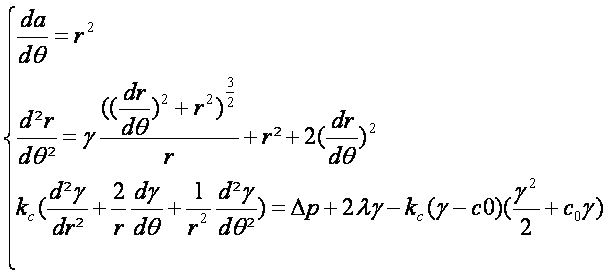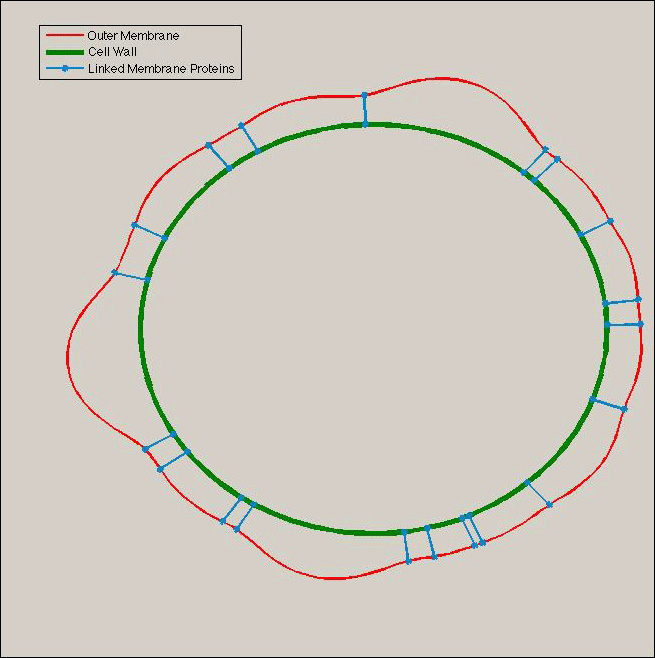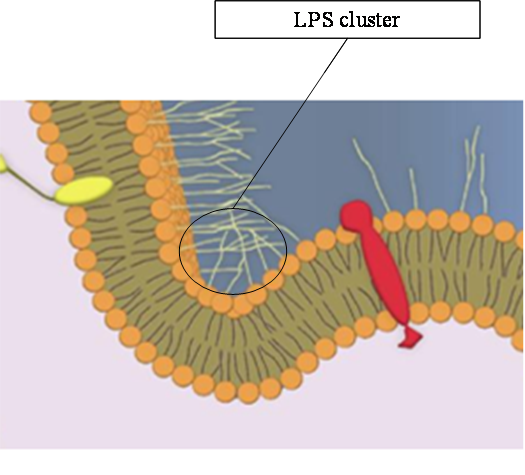Team:Paris/Production modeling2
From 2009.igem.org
iGEM > Paris > DryLab > Vesicle biophysics Model (vesicle model)
Contents |
DryLab - Vesicles creation
Pour Samuel et gregory
Unequal pressures create small blebbing:
PIERRE J'AI FAIT DES REMARQUES DANS L'ANCIENNE VERSION AUSSI (TOUT EN BAS DE LA PAGE) A FUSIONNER AVEC CI-DESSOUS
We modelised the reaction of the membrane under the osmotic pressure. We used a simple 2 dimension model to show the creation of blebbing under pressure increase. We simplified the equation given by Ou-Yang and Helfrich [Phys. Rev. Lett. 59 (1987) 2486], which describes the membrane conformation under unequal pressure:
- Where H is the mean gaussian curvature and K is the Gaussian curvature :
- The principal curvatures of a surface on the point M are defined as the minimum and the maximum curvature at this position of the curves described by cuting the surface with plans containing the normal direction at this point.
- We first simplified the membrane equation to a 2 dimensional equation system based on a polar curvature simplification approximation :
- the curvature in polar is
- With the hypothesis of a cylinder form the mean and gaussian curvatures can be written as:
- indeed we have in those hypothesis:
- Thous we can concider the polar system of equation:
- to have a unique solution we must use some boundary conditions to compute our model (Cauchy Lipshitz thorem for the mathematician ;)) those conditions are simple without the peptidoglycan attachement lypoproteins (Pal). As the model is dependent of the angle we must impose the fact that r(0)=r(2π). In addition the Δp must be concidered as dependent of the quantity of periplasmic species.
- Indeed the osmotic pressure can be written in this way:
- And by concidering that we have low concentrations we can concider a simpliest formula analogue to the perfect gases law:
- Finaly we can write:
- And Thus the whole parameters are given. In addition, we can translate the role of the Tol/Pal System as boundary condition on the whole system: a cluster of Tol-Pal can be considered as a point with a radius equal to the peptidoglycan ones. Finally, we were able to obtain this type of behavior:
fig1 seek for legend
The lipid surface conformation
- The Lipid conformation of the outer membrane is a well known problem: at 35°c the lipid bilayer behaves like a liquid which conformation character is ruled by an energy called the bending energy. This energy represents the fact that the lipid bilayer will search a special conformation depending on the shape and the chemical properties of its constituents. In order to explain the way lipids organize together we need an expression for the membrane bending energy. This is given by :
- E is the energy of a whole lipid bilayer (or monolayer). Kb and Kg are Bending and Gaussian moduli which can be obtained by experiments. γ0 is the intrinsic curvature of the outer membrane which describes the local form of a lipid bilayer when it is at is lowest state of energy ,the more stable. γm and Hg are the mean curvature and the gaussian curvature( see Helfrich [Z. Naturforsch. C 28 (1973) 693] ). dS is a surface infinitesimal element and the previous formula relates how the local surface energy varies with the local mean curvature and the Gaussian curvature. Let us first calculate the energy of two different shapes of membranes, (i) a model of the shape of E. coli before budding, and (ii) after budding of a vesicle.
- (i) We consider the shape of E.coli as a cylinder of radius r =0.3.
- This is a simplified shape based on the heuristic fact that in septa where the vesicle will be constituted principally with lipids of higher bending energy. In fact this model is just a first approach to determine range of parameters and could be developed in a more sophisticated way later.The aim of this first representation is to estimate this energy in the division region of E.coli before division. With this approximation γm = 1/2r.
- Thus for the E.coli lipids membrane the bending energy per aera is:
- (ii) For the vesicles we consider their basic shape as a sphere of rayon r’ so the bending energy by lipid area units is:
- Thus as the area of a sphere is known and is independent of the location on the surface we can write:
- The energy of the same membrane area in E.coli is:
- The relations can provide a basic vision of the statistical repartition of vesicles in case of absence of integrity control system in the outer membrane.
- Ee is the potential energy of the lipid area in E.coli outer membrane before construction of a vesicle and Ev is the energy of the same lipid area but in the conformation after budding including a vesicle shape. So the energy which must be given to the whole system to create a vesicle is:
Mettre une courbe expliquant ceci
- We can suppose that the most easily created vesicles will be the ones which require a minimum energy. By derivation we find that the minimum is obtain for:
- Hence as we know that the range of created vesicles radii is 25 nm to 175nm we can suppose that the r’ is somehow about 100 nm. This leads us to an estimation of the outer membrane intrinsic curvature:
- Which is realistic in the order of magnitude
- In fact we know that the E.coli lipid bilayer is built of distinct types of lipids: Lippopolysacharides (LPS) and simple phospholipids. LPS are located in the exterior lipid layer of the outer membrane. The others are located in the interior lipid bilayer. Moreover, those LPS present a sugar extension toward the medium. Those sugars can bind to each other. So we can assume that they are going to create clusters and to curve the membrane toward the exterior of E.coli.
- This part was dedicated to a first approach of the membrane shape and its characteristics introducing some concept of lipid membrane physics. It enable us to find a range value for one important parameter.
Travail à faire
Reprendre pourquoi cette modélisation et introduire ce quel'on fait ici. Par ex. In this section we are going to develop an original biophysical model developed to explain the formation of vesicles. This study aims at a better understanding of the mechanisms leading to the production of vesicles by the cell a process still very poorly described [Références] despite the natural occurrence of this phenomenon in gram-negative bacteria. Knowledge of the underlying processes can prove valuable in the perspective of optimizing inter-cellular communication by vesicle transport.
Our model is based on three different physical phenomena: (i)The lipid surface conformation, (ii) Tol-Pal proteins diffusion and (iii) the increase of the osmotic pressure in the periplasm
The lipid surface conformation
The conformation of the lipid outer membrane is a well... The Lipid conformation of the outer membrane is a well known problem: at 35°c the lipid bilayer behaves like a liquid which conformation character is ruled by an energy called the bending energy. This energy represents the fact that the lipid bilayer will search a special conformation depending on the shape and the chemical properties of its constituents.
We first use the bending energy has a rough shape for our model and its understanding: Phrase pas claire. Par ex. simplement
In order to explain the way lipids organize together we need an expression for the membrane bending energy. This is given by
where E is the energy....
OUT(::This formula give use the abilities to explain the way lipids will organize together)
E is the energy of a whole lipid bilayer (or monolayer). Kb and Kg are Bending and Gaussian moduli which can be obtained by experiments. γ0 is the intrinsic curvature of the outer membrane which describes the local form of a lipid bilayer when it is at is lowest state of energy ,the more stable. γm and Hg ce n'est pas plutôt γg?are the mean curvature and the gaussian curvatureImpérativement une référence. dS is a surface infinitesimal element and the previous formula relates how the local surface energy varies with the local mean curvature. (JUSTE?)
Let us calculate first the energy of two different shapes of membranes, (i) a model of the shape of E. coli before budding, and (ii) after budding of a vesicle.
SUPPRIMER A. We compute the shape of E. coli before the division and then the vesicles' shape.
Pourquoi cette configuraiton correspond à la région de division de E.coli?
- (i) We consider the shape of E.coli as a cylinder of radius r =0.3 μm and of infinite length.
Pourquoi longueur nifinie?The aim of this first representation is to estimate this energy in the division region of E.coli before division. With this approximation γm is equal to 2/r and γg=0. In this case:
Comme tu l'utilises après, explicite Ee ici, il me semble que c'était un élément que tu voulais citer mais qui manquait
Thus for the E.coli lipids membrane that the bending energy is:
A PLACER Expression pour Ee=
- (ii) For the vesicles we consider their basic shape as a sphere of rayon r’ so the bending energy by lipid area units is:
ORGINAL avec confusions me semble t'il Thus as the area of a sphere is known and is independent of the location on the sphere we can write: In the same way we can write for an area of E.coli lipids that the bending energy is:
- Thus as the area of a sphere is known and is independent of the location on the sphere we can write:
Tu es sûr? Essentiellement on multiplie ici par la surface de la sphère A\pi r'^2 pourquoi le dernier terme à droite est seulement Kg?
The relations can provide a basic vision of the statistical repartition of vesicles in case of absence of integrity control system in the outer membrane.
Quelle "first" energy et quelle "second" one?? Pas clair The first energy is the potential energy of the lipid area in E.coli outer membrane necessary to the construction of a vesicle and the second one the potential energy of the same lipid area but in the conformation of a vesicle shape. So the energy which must be given to the whole system to create a vesicle is:
J'interprète.... vois si on est d'accord: Ee is the potential energy of the lipid area in E.coli outer membrane before construction of a vesicle and Ev is the energy of the same lipid area but in the conformation after budding including a vesicle shape. So the energy which must be given to the whole system to create a vesicle is:
We can suppose that the most easily created vesicles will be the ones which requires a minimum energy. By derivation we find that the minimum his obtain for:

|
- Hence as we know that the range of created vesicles radii is 25 nm to 175nm we can suppose that the r’ is somehow about 100 nm. This leads us to an estimate of the outer membrane intrinsic cuurvature:
Which is realistic in the order of magnitude.
In fact we know that the E.coli lipid bilayer is built of distinct types of lipids: Lippopolysacharides (LPS) and simple phospholipids. LPS are located in the exterior lipid layer of the outer membrane. The others are located in the interior lipid bilayer. Moreover, those LPS present a sugar extension toward the medium. Those sugars can bind to each other. So we can assume that they are going to create clusters and to curve the membrane toward the exterior of E.coli.
AU MOINS UN SCHÉMA SERAIT IMPORTANT POUR ETTAYER CE QUI PRECEDE
ON PASSE DANS UNE AUTRE PARTIE: petite conclusion de ce qui précède et introduction de la suite
"Tol-Pal proteins diffusion"
Tol and Pal are membrane proteins which are located respectively in the outer and the inner membrane. The diffusion of proteins in those lipid bilayers can be modelled by a probabilistic Brownian movement. This diffusion model gives us the law of probability for the location of Tol and Pal on the membranes. It has been observed that the Tol and Pal proteins interact with each other, which is linked to the membrane stability: indeed the Tol and Pal will bind inner and outer membrane and furthermore stabilize the outer membrane using the peptidoglycan rigidity. FAIRE UN RENVOIT A LA PARTIE DU WIKI QUI PRESENTE LE SYSTEME TOL-PAL OU INCLURE ICI UN SCHEMA
"Periplasmic osmotic pressure increase"
The osmotic pressure in the periplasm is the same that the medium pressure in normal time. But during the division period of the bacteria the peptidoglycan is degraded to be recycled in a new cell wall. During this phenomena of turn-over a part of the peptidoglycan is released in the periplasm which increased its osmotic pressure.
Thus, we can consider that if there is not enough Tol-Pal linked proteins the outer membrane will distort to create a beginning of vesicle. But in this part of the membrane the tol pal proteins will not have the possibility to bind themselves and they will be free to diffuse in other parts of the membranes. The surface shape will guide the proteins to the border of the vesicle and stabilized the shape of the vesicle.
A FIGURE IS WORTH 1000 WORDS !
To describe thevesicles creation we first have to use a more complete approach and need to use an equation relation the osmotic pressure difference between the inside and outside of the cell and the equilibrium shape (Ou-Yang and Helfrich [Phys. Rev. Lett. 59 (1987) 2486]):
DECRIRE LES PARAMÈTRES
J'ai réécrit en partie ici. Relis stp
Simplified approach: without brownian motion of the intermembrane Tol-Pal links
In the following we first consider a model without brownian movement of the Tol-Pal links that are considered immobilized and randomly distribute over E.coli membrane. We look also here at a simplified one dimensional membrane. Our aim is to get a visual representation of the equilibrium shape of the outer membrane for a given osmotic pressure difference. In one dimension and in polar coordinates the membrane equation of the vesicle simplifies well.
In polar coordinates the curvature is:

|
Definir r' et r. Faire apparaître la coordonnée angulaire
r' is the first derivative of r in theta. 'todo put a formula
CHANGE AVEC CE QUI SUIT ::With the hypothesis of a cylinder form the mean and gaussian curvatures can be written as:
Here also we assume a cylindrical mean shape, and hence the mean and gaussian curvatures can be written as:

|
- indeed we have in those hypothesis:
Due to cylindrincal symetry the principal curvatures are always equal to the curvature in the perpendicular plane of the cylinder and the

|
::Thous we can concider the polar system of equation: REMPLACÉ PAR
With these relations the membrane equation becomes:

|
We can now integrate this system and obtain a representation of the equilibrium shape of the outer membrane. To compute the model and to obtain a unique solution we must use some boundary conditions (Cauchy Lipshitz thorem for the mathematician ;)). These are given bythe case without the peptidoglycan attachement lypoproteins (Pal) QUELQUES DETAILS EN PLUS. As the model is dependent of the angle we must impose the fact that r(0)=r(2π) to account for closing the vesicle..
Finally, we include also in the model the fact that the Δp must be considered as dependent of the quantity of periplasmic species. Indeed the osmotic pressure can be written in this way:
And by considering that we have weak concentrations we obtain a simpler formula analogue to the perfect gas law:
Giving finally for the osmotic pressure difference:
MAIS COMMENT TU UTILISES CETTE EXPRESSION? \Delta P, ou bien 'n' n'est ce pas un paramètre que tu imposes (et éventuellement par la suite feras varier pour faire pousser les vésicules?
MAIS COMMENT TU UTILISES CETTE EXPRESSION? \Delta P Here we can see that the model is depending of the volume V which will stabelised the equation and define totaly the whole parameters of the model dynamic
ABSOLUMENT PAS CLAIR...::And Thous the whole parameters are given. In addition we can translate the role of the Tol/Pal System has boundary condition on the whole system: a cluster of tol-Pal can be translate as a point of radius equal to the peptidoglycan ones. Finally we can have this type of results:
The integration of the polar membrane equations gives results of the following type:

|
Légende:
Equilibrium shape of the outer membrane (red) with immobile Tol-Pal links fixed to the inner membrane (green) assumed cylindrical.
Treatment including brownian motion of the intermembrane Tol-Pal links
We will now let the Tol-Pal links between the cell outer and inner membranes move freely with a brownian motion. This motion links the local concentration of proteins with the shape of the membrane they are included in. The diffusion of this links is described by:

|
where P is the proteins presence density of probability .
PIERRE, JE ME RAPPELLE QUE TOL ET PAL DIFFUSAIENT INDEPENDEMMENT ET POUVAIENT QUAND ILS SE RENCONTRAIENT FORMER DES LIENS. C'EST CE QUI SE PASSE ICI OU BIEN CE SONT DE LIENS TOL-PAL DEJA FORMES QUI DIFFUSENT? ETRE PLUS CLAIR ICI
The Laplacian of P explains the fact that the concentration of proteins like Pal increased in regions of negative curvature. Such a model can explain some recent observations [Kumaran & Losick] “negative membrane curvatures as a cue for sub-cellular localization of a bacterial protein”. According to this we can assume that the Pal will be confined to region with negative curvature. In those regions the probability of linking between Pal and Tol is increased which enhances the local membrane stability and contributes to enlarge these regions. PAS CLAIR POURQUOI LA VESICULE EST MURE.... Then the vesicle is mature.
::So Brownian motion is a good explanation for the proteins migration toward the septa during division. PAS CLAIR SI GARDER
- But this Brownian motion can explain the vesiculation too.
This reinforcement process driven by brownian motion can explain the vesiculation.When there are too few proteins we can assume the creation of a vesicle at germinal states (called bleb). At the border of the blebs an amount of Pal protein prevent the whole membrane to swallow and keep the vesicle in form. But at the border between the blebs and the protein rich area curvature is highly negative and so the quantity of proteins in those regions increases enlarging the region toward the centre of the blebs.
UN SCHEMA IMPERATIF
- Then two different options are expectable: the blebs is too small and then the proteins are “zippering” back the blebs. But if the bleb is big enough the zippering became a separation between the vesicle and the bacteria. The good vision of this blebs forming can be understood in this way: the proteins rich region on the border pass from an annular form toward a circular one.
 "
"


